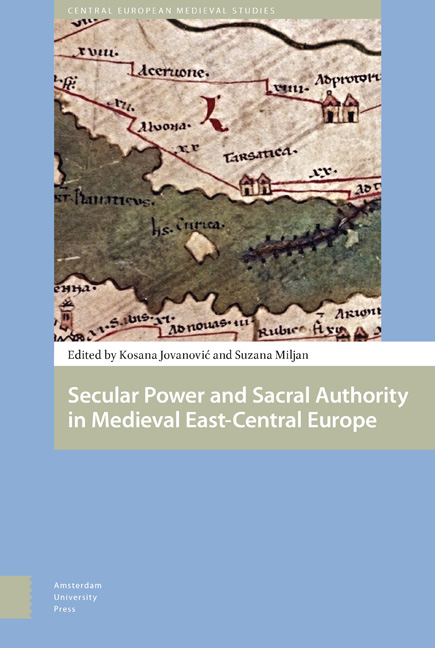Book contents
- Frontmatter
- Contents
- List of Figures and Tables
- Acknowledgements
- Foreword
- Folklore of the Medieval Kings of Hungary: Preliminary Research Report
- Variations on Nobility in Central and South-Eastern Europe: An Introduction
- The Changes of Office of Ban of Slavonia after the Mongol Invasion in Hungary (1242-1267)
- The Reconstruction and Role of Roads in the Formation of a Medieval Cultural Landscape: The Example of Episcopal Estates of Dubrava, Ivanić and Čazma
- From Castle-Warrior to Nobleman: Case Study of a Family of Slavonian Lesser Nobility
- Late Medieval Village in Turopolje (Slavonia): The Example of Donja Lomnica
- Economic Development and Transformation of the Pauline Monasteries near Senj under the Frankapan Patronage
- The Society of the Noble Judges in Northeastern Hungary during the Reign of King Sigismund (1387-1437)
- Development of Ragusan Diplomatic Service in the First Half of the Fifteenth Century: Father and Son at the Court of Duke Sandalj Hranić
- Croatian Students at the University of Prague in the Fifteenth Century
- A Contribution to Medieval Croatian Diplomatics: Cyrillic Charters of Croatian Nobility from the Franciscan Monastery on Trsat in Rijeka
- Peter of Crkvica, a Man Who Could Be Trusted: The Career of a Middle-Ranking Cleric and Diplomat in the Kingdom of Hungary in Mid-Fifteenth Century
- The Nobility of the Despotate of Serbia between Ottoman Empire and Hungary (1457-1459)
- List of Contributors
- Index
Late Medieval Village in Turopolje (Slavonia): The Example of Donja Lomnica
Published online by Cambridge University Press: 12 December 2020
- Frontmatter
- Contents
- List of Figures and Tables
- Acknowledgements
- Foreword
- Folklore of the Medieval Kings of Hungary: Preliminary Research Report
- Variations on Nobility in Central and South-Eastern Europe: An Introduction
- The Changes of Office of Ban of Slavonia after the Mongol Invasion in Hungary (1242-1267)
- The Reconstruction and Role of Roads in the Formation of a Medieval Cultural Landscape: The Example of Episcopal Estates of Dubrava, Ivanić and Čazma
- From Castle-Warrior to Nobleman: Case Study of a Family of Slavonian Lesser Nobility
- Late Medieval Village in Turopolje (Slavonia): The Example of Donja Lomnica
- Economic Development and Transformation of the Pauline Monasteries near Senj under the Frankapan Patronage
- The Society of the Noble Judges in Northeastern Hungary during the Reign of King Sigismund (1387-1437)
- Development of Ragusan Diplomatic Service in the First Half of the Fifteenth Century: Father and Son at the Court of Duke Sandalj Hranić
- Croatian Students at the University of Prague in the Fifteenth Century
- A Contribution to Medieval Croatian Diplomatics: Cyrillic Charters of Croatian Nobility from the Franciscan Monastery on Trsat in Rijeka
- Peter of Crkvica, a Man Who Could Be Trusted: The Career of a Middle-Ranking Cleric and Diplomat in the Kingdom of Hungary in Mid-Fifteenth Century
- The Nobility of the Despotate of Serbia between Ottoman Empire and Hungary (1457-1459)
- List of Contributors
- Index
Summary
The research of late medieval villages is a relatively recent topic in Croatian medieval archaeology. Highway excavations, by enabling the research of the biggest areas that researchers ever had the opportunity to investigate, contributed to this interest. Still, highway excavations face certain problems – both the site of the excavations and the length of the excavated site are determined by the right-of-way of the highway. As a consequence, some of these sites face difficulties of interpretation. Although the investigated areas are big, they are still limited and often do not give enough data to make general conclusions about the layout of the late medieval village. On the example of village of Donja Lomnica, with the help from written sources, onomastics and ethnographic data we can try to gain some more information about the functioning of the village system of a certain area. These results can be only partial, but different kinds of sources combined together can point to possible guidelines that could lead to better understanding of archaeological finds and historical and onomastic sources.
Turopolje is an area south of Zagreb; that is south of the river Sava that marks its northern border. On the other side, it is bounded by the Samoborsko Gorje hills to the west, the confluence of the Kupa and Sava rivers to the southeast, and the Vukomeričke Gorice hills to the southwest. The whole area measures approximately 600 square kilometres, and it consists of three parts. A plains area in the north (traditionally called ‘polje’ [field]), a mountain area called Vukomeričke Gorice (‘vrhovlje’ [peaks]) on the south, and Veliki Turopoljski lug (a marshy area) on the southeast. Turopolje was situated in Slavonia, a constituent part of the medieval Kingdom of Hungary-Croatia.
As a result of special historic circumstances, the medieval as well as modern history of the region was most known because of the noble community of Turopolje. Its members were iobagiones castri, castle warriors of the castle of Zagreb, who managed to preserve their privileges long after the disintegration of the castle system. They owed military service to the king and, in return, they owned their land hereditarily and were exempt from taxes.
- Type
- Chapter
- Information
- Publisher: Amsterdam University PressPrint publication year: 2018



